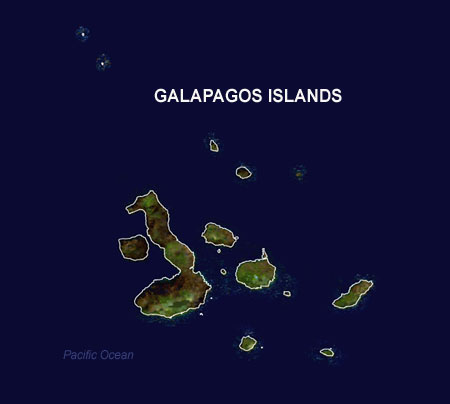|
CAS IN THE GALÁPAGOS ISLANDS
The Galápagos Islands are deservedly famous for the role they played in the formulation of the theory of evolution. However, long before Darwin ’s 1835 visit on the HMS Beagle, the Galápagos Islands were a provisioning stop for empire builders, pirates, and whalers. As a result, by the 19 th century, the unique life forms of this isolated island group had been severely depleted. At the time that scientists were beginning to recognize the value of the Galápagos as a natural laboratory for understanding speciation and evolution, those same unique species were disappearing.
In 1905, CAS launched a 17-month sailing expedition to the Galápagos in an effort to document its vanishing species and to expand the Academy’s valuable and growing specimen collections. While the expedition crew was at sea, a great earthquake struck San Francisco on April 18, 1906. The Academy’s downtown building, including most of its collections, were destroyed in the temblor and subsequent fires. When the schooner sailed into San Francisco on Thanksgiving Day, 1906 carrying thousands of specimens of Galápagos tortoises, birds, reptiles, plants, insects, and fossils, a new Academy of Sciences was born. The Galápagos have remained a central focus of CAS research and exploration ever since.
In 1932, Templeton Crocker funded another Galápagos expedition, aboard the now legendary Sausalito-built schooner, Zaca. On this trip, CAS scientists undertook an unprecedented effort to share the ‘living laboratory’ of the Galápagos Islands with the general public. 331 live specimens were collected and transported for display at the Steinhart Aquarium in Golden Gate Park. To this day, the Academy continues in its historical tradition of Galápagos research, exploration, and public education.
Learn more about the people and institutions involved and our conservation actions in the Galápagos.
|
 |
People and Institutions
The 1960 opening of the Charles Darwin Research Station on Academy Bay (named after the California Academy of Sciences) marked the beginning of an international initiative to conduct modern research in the Galápagos. With support from the National Science Foundation, CAS and the Charles Darwin Foundation launched the Galápagos International Scientific Project. For eleven weeks, over 60 scientists, including 10 biologists from CAS, explored remote areas by helicopter, tagged and monitored the island’s giant tortoises, generated the first complete list of Galápagos flora, and discovered dozens of new species. The expedition medical doctor, Jerold M. Lowenstein, provides an engaging chronicle of his participation in the 1964 “Galápagos Adventure” 40 years later.
In recent decades, the CAS scientist most actively involved in Galápagos research is Dr. John McCosker, former director of the Steinhart Aquarium and current Chair of the department of Aquatic Biology. Dr. McCosker has spent nearly 30 years studying the composition, relationships and origins of the Galápagos fish fauna. Venturing to places Darwin could only dream of, Dr. McCosker and his colleagues have traveled to depths of 3000 ft (914 m) to survey the undersea world of the Galápagos Islands. Facilitated by state-of-the-art scuba equipment and submersible diving technologies, their research revealed new species and new behaviors of fish and invertebrates, as well as startling observations of the effects of El Nino on local marine biota.
In 1994, Dr. McCosker organized a Galápagos marine biotic survey with colleagues from CAS, Scripps Institution of Oceanography, and the National Fisheries Institute of Ecuador. Almost two dozen species new to science were found, including 18 new species of nudibranchs described by Academy Provost Dr. Terry Gosliner. Dr. McCosker added 11 new species to his list of Galápagos shore fishes, which now totals 336 species, 20% of which are endemic to the island archipelago.
Conservation Actions
The geographic isolation of the Galápagos islands has resulted in the evolution of an assemblage of plants and animals, such as the Giant Galápagos tortoise, algae-eating marine iguanas, and the famous Darwin’s finches, that can be found nowhere else on Earth. 75% of all land birds and over 90% of the terrestrial mammals and reptiles are unique to the Galápagos. The Galápagos is the largest, most complex and ecologically diverse archipelago that remains still largely unspoiled. Both national an international policies have long recognized the conservation value of these islands. Over 95% of the archipelago’s land area of was declared a National Park in 1959, and in 1986, the Ecuadorian government decreed 70,000 km 2 of near and offshore waters as the Galápagos Marine Resources Reserve (GMRR). UNESCO declared the Galápagos a World Heritage Site in 1978.
In spite of all these conservation policies, both the marine and terrestrial habitats of these fragile oceanic islands are under siege. Increasing resident and tourist populations lead to the introduction of exotic species, which is the single most disruptive force on oceanic islands worldwide. The native fauna and flora evolved in the absence of foreign predators and competitors. Without defenses against them, populations dramatically decline and eventually go extinct. The pressures of an increasing human population have also lead to overharvesting and habitat degradation.
Read about new species described by CAS research in the Galápagos.
|

